Purchase transactions

Helpful Hint!
If you are completing our software practice set, you are asked
to record purchases of inventory into the
Purchases - New Item window and
cash purchases of non-inventory items or services using the
Spend Money
window in the Banking Command Centre.
Entering details of purchase transactions is a common activity you will perform
in your MYOB software. All purchases of inventory are to be recorded using the Purchases - New Item
window, while
cash purchases of non-inventory items or services are to be recorded using the
Spend Money
window in the Banking Command Centre.
Your MYOB software then uses this information to record the journal entry
and post the transaction to the appropriate general ledger accounts.
The appropriate supplier balances are also
automatically updated.
This topic demonstrates how to record different types of purchase transactions,
from converting a purchase order to a purchase invoice (bill)
to recording credit and cash purchases (and everything in between!).
The following topics are covered:
Converting a purchase order to a credit purchase
The process of converting a purchase order to a credit purchase in your MYOB software
involves converting the previously
recorded purchase order to a purchase invoice (bill).
To do this, first you need to find the purchase order in your MYOB software. In the
Purchases Command Centre, select Purchases Register.
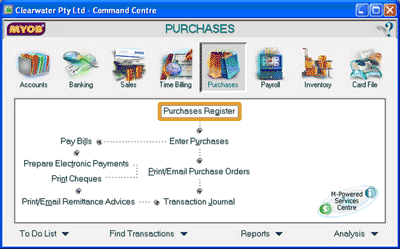
This opens the Purchases Register window. The following screenshots and reference
table show step-by-step instructions on how to
convert the purchase order to a purchase invoice (bill).
Note that each step is assigned a reference number to help you identify the appropriate
field or icon in the screenshots.
The Purchases Register window - converting a purchase order to a credit purchase
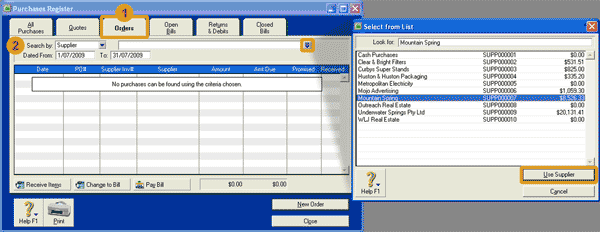
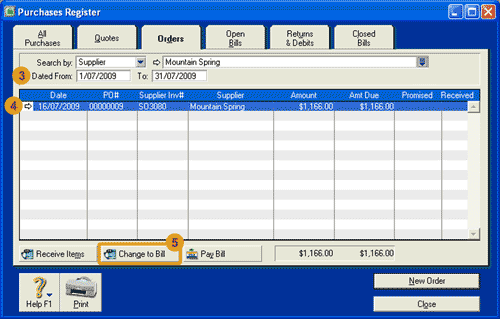
The Purchases - New Item window - converting a purchase order to a credit purchase
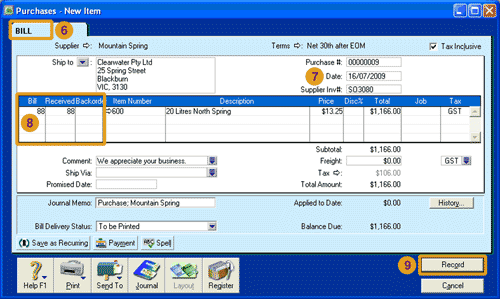
| Step |
MYOB software field or icon |
Action |
| Purchases Register window
|
 |
Orders tab |
Click the Orders tab to be able to view the purchase orders for the dates specified.
|
 |
Search by |
Select All Suppliers if you wish to display the purchase orders for all suppliers. Select Supplier
to view all purchase orders to one specific supplier. Note that if you choose Supplier, an additional
drop down field will automatically be displayed next to the 'Search by' field. Click the
search icon in this new field to display the
Select from List window where you can select the specific supplier relating to the purchase orders
you wish to view. Click the Use Supplier button to select that supplier.
|
 |
Dated From, To |
Enter the date range for the purchase orders you wish to view. |
 |
Purchase order list |
In the list, identify the purchase order you wish to change to a purchase invoice (bill).
Select this purchase order by clicking on it.
|
 |
Change to Bill |
Click the Change to Bill button to open the Purchases - New Item window for that purchase order.
|
| Purchases - New Item window
|
 |
BILL tab
|
Notice that the Purchases - New Item window displays the BILL tab and is coloured blue, the
colour your MYOB software uses for purchase invoices (bills). All of the information
from the purchase order has been transferred
to this bill.
|
 |
Date |
Enter the date of the invoice, that is, the date the goods are received.
|
 |
Bill,
Received,
Backorder
|
Your MYOB software automatically populates the Bill and Received columns
with the number of items ordered. If you received less
than the number of items ordered in the purchase order, enter the number of items
still to be delivered in the Backorder column. The purchase order will be updated
to show the number of items yet to be received.
|
| Helpful hint!
|
You can add additional items of inventory to this invoice by entering the
details in a new row. For details of how to enter this information, see steps 7 - 10
in the following topic, Recording credit purchases.
|
 |
Record |
Check that all the details in the purchase invoice (bill)
are correct and click the Record button to record
the purchase. You may be presented with a popup that says
"This purchase is pre-dated. Click cancel if you do not wish to record it."
Please click OK.
|
top
Recording credit purchases
Recording a credit purchase of inventory from a supplier into your MYOB software is very similar to recording
a purchase order, except that you select BILL rather than ORDER in the Purchases - New Item window.
To record a credit purchase into your MYOB software, open the Purchases Command Centre and select Enter Purchases.
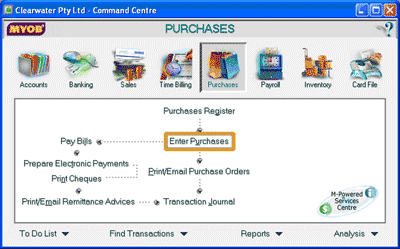
This displays the Purchases - New Item window. In the top left hand corner of this window there is a
field from which you can choose QUOTE, ORDER, RECEIVE ITEMS or BILL. If BILL is not already
displayed in this field,
click the arrow next to this field and change the field to BILL.
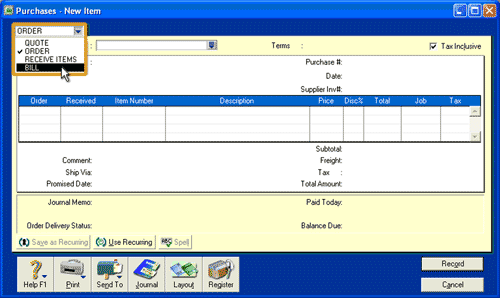

Helpful Hint!
If you are completing our software practice set
and the title of the window is not Purchases - New Item, it is
because your MYOB software is displaying a different layout for that window.
To change this to the Purchases - New Item window,
click the Layout icon at the bottom of the window. In the Select Layout window that appears,
select Item and
click the OK button. The title of the window should automatically change to Purchases - New Item.
You should now notice that the colour of the window has turned blue, the colour your MYOB software uses
in the Purchases - New Item window to indicate that
you are recording a purchase invoice (bill).
Here, you can enter the details of the credit purchase into your MYOB software.
The following screenshots and reference table show step-by-step instructions on
how to enter a credit purchase into the Purchases - New Item window.
Note that each step is assigned a
reference number to help you identify the appropriate field or icon in the
screenshots.
The Purchases - New Item window with reference numbers
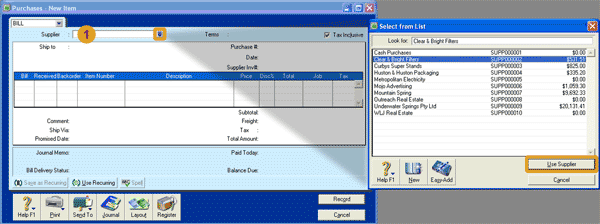
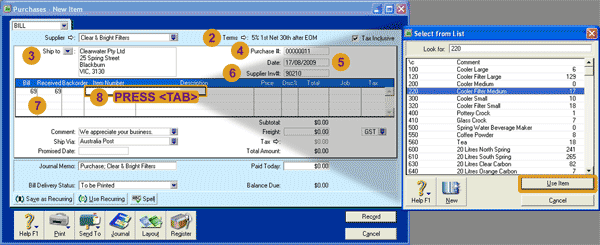
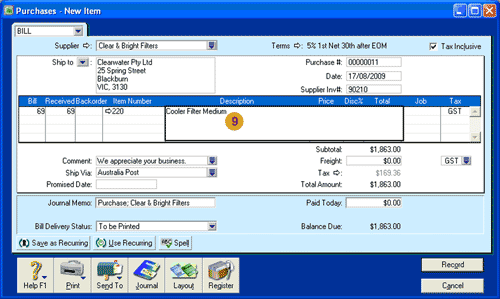
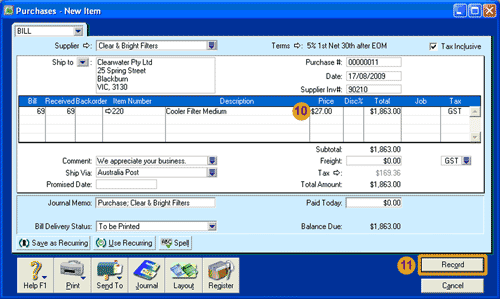
| Step |
MYOB software field or icon |
Action |
 |
Supplier |
Click the search icon to open the Select from List window where you can select the supplier
to which the purchase relates to. Click the Use Supplier button to select the supplier. Notice that
when you select the supplier, your MYOB software automatically populates certain fields with
information about the supplier that you entered when you added the supplier into your MYOB software
during the setup process. You can accept that information or manually change it for this
purchase.
|
 |
Terms |
This field is automatically populated when you select the supplier. You can accept this information
or change it for this purchase by clicking on the zoom arrow. |
 |
Ship to |
This field is automatically populated with the name and address of your business
that you entered when you set up your company file.
|
 |
Purchase # |
Accept the purchase number your MYOB software automatically assigns to this
bill or enter the purchase number you
wish to use.
|
 |
Date |
Enter the date of the credit purchase.
|
 |
Supplier Inv#
|
Enter the supplier's invoice number in the Supplier Inv# field if known.
|
 |
Bill,
Received
|
Enter the quantity of the first item ordered. Notice that when you click out of the Bill column,
your MYOB software automatically populates the Received column with the number of items entered
into the Bill column.
|
 |
Item Number |
Enter the item number of the item of inventory purchased. If you do not already know the item number,
click into this cell to select the cell. You should notice that a box appears around the cell.
You should then press <tab> on your keyboard to display the Select from List window
where you can scroll through the list of inventory items. Click on the appropriate item of inventory to select it,
then click the Use Item button.
|
 |
Description |
When you select the item of inventory using the Item Number field, your MYOB software automatically populates
this field with the longer description of the item of inventory. Read this description to
check that you have selected the correct item. Then press <tab> on your
keyboard to move to the next field.
|
 |
Price,
Total,
Tax
|
If you have purchased this item before, your MYOB software automatically populates
the price field with the last price paid for that item of inventory. You can either accept this price
or enter a new price into this field.
Note that if you change the price, your MYOB software
automatically calculates the new Total for that number of items. Alternatively you can change
the amount recorded in the Total column and
your MYOB software will calculate the percentage discount and record it in the Disc% column.
If this is the first time you are purchasing that type of inventory, enter the price of one
unit of that inventory item into the Price field. Your MYOB software automatically calculates the
total for that number of items.
Your MYOB software automatically populates the Tax column with the default information
specified when that item of inventory was set up.
|
| Helpful hint!
|
You can enter additional items of inventory ordered by repeating steps
7 to 10 in a new row.
|
 |
Record button
|
Once you have reviewed the information entered for the purchase, remember to click the
Record button to record the purchase.
|
top
Recording part cash part credit purchases
Recording a part cash and part credit purchase involves recording the full amount of the
purchase into the Purchases - New Item window, just like recording a credit purchase.
Then, the cash payment is recorded separately in the Pay Bills window.
Note that you are able to record any cash payment made to the supplier while recording the
credit purchase in the Purchases - New Item window. However, if you are completing our
software practice set we recommend that you use the Pay Bills
window to record the cash payment. This is because the Purchases - New Item window
does not show all line items in which you are able to view and record the details of the cash payment.
For instructions on how to record the purchase into the Purchases - New Item window see the
Recording credit purchases instructions as just described.
Then, in the Purchases Command Centre select Pay Bills to open the Pay Bills window.
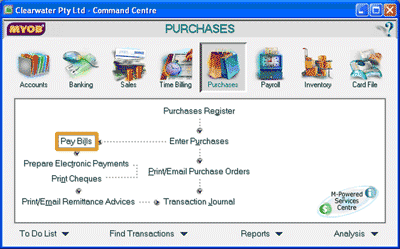
This opens the Pay Bills window where the payment to the supplier can be recorded.
The following screenshots and reference table show step-by-step instructions
on how to record the cash payment to the supplier into the Pay Bills window.
Note that each step is assigned a reference number to help you identify the appropriate
field or icon in the screenshots.
The Pay Bills window with reference numbers
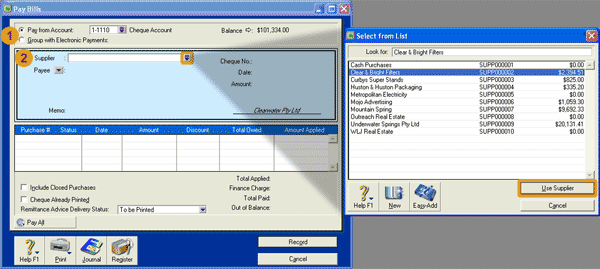
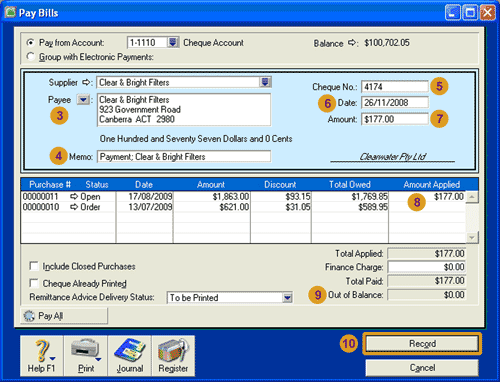
| Step |
MYOB software field or icon |
Action |
 |
Selecting the account |
There are two options to select the general ledger account from which the payment will be recorded.
Pay from Account:
If the payment is to be made directly from a bank account, such as for a cheque or credit card payment,
select the Pay from Account option.
Then click the search icon to open the Select from List window where
you can select the general ledger account
that records payments from that
bank account.
If you are completing our software practice set,
for cash payments made to suppliers that the business pays by cheque,
you are asked to select the
Pay from Account option and then select the Cheque Account.
Group with Electronic Payments:
Select this option if you are going to include this payment with a group of electronic payments.
Once all electronic payments have been recorded in the Pay Bills window, you can then use the
Prepare Electronic Payments window in the Banking Command Centre to make the electronic payment.
If you are completing our software practice set,
you are not required to make electronic payments.
|
 |
Supplier |
Click the search icon to open the Select from List window where you can select the supplier
to which you are making the payment. Click the Use Supplier button to select the supplier. Notice that
when you select the supplier, your MYOB software automatically displays the purchase invoices (bills)
yet to be paid to that supplier. These invoices are known as open bills.
|
 |
Payee |
Your MYOB software automatically
populates this field with the name and address of the supplier you selected.
Note that the Payee field is not displayed if you selected Group with Electronic Payments.
|
 |
Memo |
Type in a description of the transaction or any other relevant information.
|
 |
Cheque No. |
Accept the cheque number your MYOB software
automatically assigns to this cash payment or enter the cheque
number you wish to use.
|
 |
Date
|
Enter the date of the cash payment.
|
 |
Amount |
Enter the full amount of the cash payment, including tax if applicable.
|
 |
Amount Applied |
Find the invoice (bill) you wish to apply the cash payment to and click in the cell in the Amount Applied column for that
invoice. Notice that your MYOB software then automatically populates this cell with the amount
recorded in the Amount field.
|
 |
Out of Balance |
This cell reports the difference between the amount entered in the Amount field and the
total of the Amount Applied column.
Check that the out of balance amount is $0.00 otherwise you will not be able to record the payment. If you have just entered
an amount in the Amount Applied column or the Amount field, you may need to click out of these cells before
your MYOB software recognises the amount you have entered into those fields and automatically updates the Out of Balance field.
|
 |
Record |
Check that the details entered into the Pay Bills window are correct and the click the Record button to record
the payment.
|
top
Recording cash purchases of inventory with an invoice
To record a cash purchase of inventory with a purchase invoice,
follow the process to record a part cash and part
credit purchase.
The only difference is that
you enter the total value of the invoice in the Pay Bills window
rather than a partial cash payment.
Return to the top